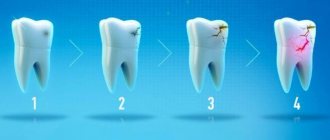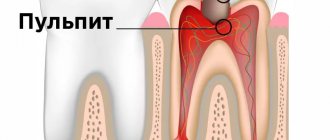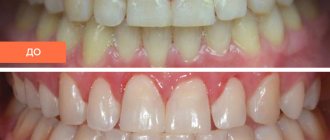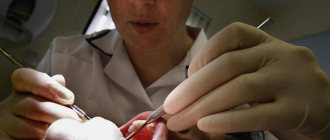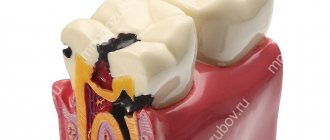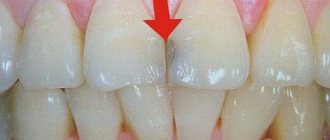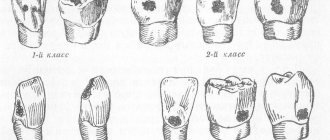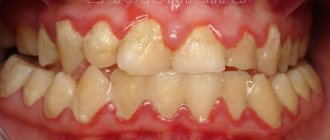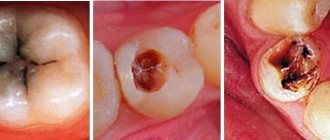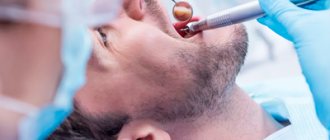Today, the latest techniques in dentistry allow dental treatment to be completely painless, quick, easy and non-traumatic. Amazing advances in science are increasingly part of the standard of care for patients. Today, there are so many amazing methods used in the treatment of teeth and gums that we want to share them. After all, many people probably remember the old Soviet dentistry and are still afraid of doctors. However, now a visit to the doctor is more a pleasure than an unpleasant event.
What does super-medicine offer us?
Finding out the nature of the disease
Caries is a disease that usually begins under plaque on the teeth. It is caused by bacteria formed during the fermentation of pieces of food left on the teeth. The bacteria are mainly Streptococcus mutans, but others may be involved. They produce acid, which eats away the enamel of the teeth and washes out minerals, forming pores.
At the first stage of caries (spot stage), demineralization of the enamel occurs.
If the stain is not treated promptly, defects will form in the tooth. Caries eats away the cavity in the tooth. It can be superficial, medium and deep, depending on how advanced the disease is.
The progression of this disease can occur without symptoms, especially at an early stage, so it is very important to periodically visit the dentist in order to eliminate the disease in a timely manner.
That is, the treatment of this disease aims to restore the functionality of dental tissues, eliminate the cavity and restore the tooth’s hardness.
On a note! It is important not only to treat caries efficiently so that the tooth lasts a long time, but also to diagnose it in time. For accurate diagnosis of the disease, as well as for treatment, the most innovative clinics today use a dental microscope. The device allows you to identify pathology in the initial stage, as well as carry out treatment while preserving the maximum volume of healthy tissue and installing a beautiful, tight-fitting filling that merges with natural enamel.
Sources
- Al-Obaidi R., Salehi H., Collart-Dutilleul PY., Jacquot B., Tassery H., Cuisinier FJG., Gergely C., Cloitre T. Relationship between Changes in Chemical Composition of Enamel Subsurface Lesions and the Emitted Nonlinear Optical Signals: An in vitro Study. // Caries Res - 2021 - Vol54 - N2 - p.144-153; PMID:32107346
- Al-Obaidi R., Salehi H., Desoutter A., Tassery H., Cuisinier F. Formation and assessment of enamel subsurface lesions in vitro. // J Oral Sci - 2021 - Vol61 - N3 - p.454-458; PMID:31341119
- Innes NPT., Chu CH., Fontana M., Lo ECM., Thomson WM., Uribe S., Heiland M., Jepsen S., Schwendicke F. A Century of Change towards Prevention and Minimal Intervention in Cariology. // J Dent Res - 2021 - Vol98 - N6 - p.611-617; PMID:31107140
- Yucesoy DT., Fong H., Gresswell C., Saadat S., Chung WO., Dogan S., Sarikaya M. Early Caries in an In Vivo Model: Structural and Nanomechanical Characterization. // J Dent Res - 2021 - Vol97 - N13 - p.1452-1459; PMID:30067915
- Mira A. Oral Microbiome Studies: Potential Diagnostic and Therapeutic Implications. // Adv Dent Res - 2021 - Vol29 - N1 - p.71-77; PMID:29355422
- Ogretme MS., AbualSaoud D., Hosey MT. What preventive care do sedated children with caries referred to specialist services need? // Br Dent J - 2021 - Vol221 - N12 - p.777-784; PMID:27981972
- Nazemisalman B., Farsadeghi M., Sokhansanj M. Types of Lasers and Their Applications in Pediatric Dentistry. // J Lasers Med Sci - 2015 - Vol6 - N3 - p.96-101; PMID:26464775
- van der Veen M.H. Detecting Short-Term Changes in the Activity of Caries Lesions with the Aid of New Technologies. // Curr Oral Health Rep - 2021 - Vol2 - N2 - p.102-109; PMID:26317065
- Zotti F., Dalessandri D., Salgarello S., Piancino M., Bonetti S., Visconti L., Paganelli C. Usefulness of an app in improving oral hygiene compliance in adolescent orthodontic patients. // Angle Orthod - 2021 - Vol86 - N1 - p.101-7; PMID:25799001
- Chambers C., Stewart S., Su B., Sandy J., Ireland A. Prevention and treatment of demineralization during fixed appliance therapy: a review of current methods and future applications. // Br Dent J - 2013 - Vol215 - N10 - p.505-11; PMID:24264666
Materials used in modern fillings
Today, new composites have replaced outdated cements and amalgams, which were not easy to fix in the tooth, and their appearance was not very aesthetically pleasing.
It is very important that thanks to new developments there is no need for excessive preparation of the cavity and removal of healthy tissue, which was previously required to ensure high-quality fastening of the filling in the cavity.
In addition to processing a tooth with a drill, there are the following methods:
- Chemical-mechanical, when carious tissue is dissolved using chemicals and removed using instruments.
- Air-abrasive, consisting of sandblasting.
- Cleaning a carious cavity using ultrasound.
- Preparation using a laser beam.
The emergence of new adhesive techniques, which use special chemicals, has made it possible to abandon labor-intensive methods of installing fillings and significantly increase the adhesion strength of the composite to tooth tissue. There are materials that are biologically compatible with dental tissues and can perfectly adhere to the surface of the cavity regardless of its shape and with minimal grinding.
The most common materials for caries treatment are the following:
- composites;
- glass ionomer cements;
- compomers;
- ormokers.
Each material has its own characteristics and properties; they can be combined to achieve the desired effect in treatment. For this there are several different techniques regarding combination and direct application.
Dental implantation
Implantology is also developing rapidly. Implantologists around the world annually present their ideas at symposiums and congresses, many of them are gradually being implemented in life. If previously dental impressions were made to make a prosthesis, then with the advent of 3D printers and ultra-modern scanners, as in prosthetics, the technology has acquired guaranteed precision in the manufacture of implants and short operating times. The patient will not feel any discomfort with the new “teeth”, since the implants are exactly like natural teeth in shape and color. Forget about removable dentures!
Principles of treatment
Today there are two main approaches to caries treatment:
- without the use of boron (preparation);
- with preparation, when the affected tissues are drilled out.
The first approach is also called conservative therapy or invasive treatment. Its use is suitable for the treatment of initial forms of caries, as well as in the presence of a cavity.
The approach to treatment using the preparation method has several stages:
- First, the oral cavity must be prepared for the procedure. It may be necessary to remove plaque and tartar from the tooth and have all teeth professionally cleaned.
- Use of anesthesia if necessary. This is most often local anesthesia, but there are cases (panic fear of small children, multiple lesions of the teeth in the oral cavity, etc.) when general anesthesia is used.
- Then they move directly to preparation. Damaged tissue is removed from the cavity formed by caries and treated with special medications. In this way, it is possible to create conditions under which the growth of bacteria under the filling and its loss are prevented.
- Next, the cavity needs to be formed so that it can hold the filling well. Sometimes it needs to be given a special configuration so that the filling compound does not fall out. But most modern composites do not require such mechanical retention, since they are able to contact the tooth chemically.
- Insulation padding may be required. This is especially important when treating deep-stage caries. Thus, the nerve has an additional effect that protects against germs and inflammation. The gasket prevents the filling material from irritating the nerve.
- Application of a filling. First, the doctor selects its color, then isolates the diseased tooth from the rest of the oral cavity using cotton swabs or rubber dams, then applies the composite in layers. To do this, they often use such auxiliary tools as a matrix to create a gap between the filling and the adjacent dental organ, wedges that form an ideal contact point, and a retraction thread to correct the gums near the working area.
- At the final stage, processing is done. The filling is adjusted according to the bite to prevent tooth injury, pain and discomfort. They also do grinding and polishing so that there are no burrs left on the surface, plaque does not accumulate, and the filling has a natural shine.
Types and stages of dental caries
In modern dentistry there are different classifications of caries. Most often, the types of disease differ depending on the location of the process, or the degree of its severity.
Types of caries by localization
- Fissure. It begins in the natural recesses of the chewing teeth - fissures. The patient will not be able to determine this type on his own.
- Contact. Such caries begins in contact between adjacent teeth and requires timely treatment. It is a consequence of not using floss or irrigator when cleaning.
- Cervical. It forms in the area in contact with the gum and gradually destroys the neck of the tooth. It is a consequence of pronounced hard dental deposits.
- Internal (secondary). If earlier errors were made during cavity processing and material placement.
- Under the crown. It appears when the orthopedic structure does not fit tightly, which causes the accumulation of food debris.
Stages of advanced caries according to the intensity of the lesion
- Initial caries (white spot stage). This is the initial degree of damage, which is reversible and does not imply fixation of the filling material. In this situation, small spots appear on the tooth enamel, indicating the leaching of mineral salts. In this case, there is no defect on the surface; only a small area with increased roughness is observed. An effective way to eliminate the deficiency is to perform remineralization;
- Superficial caries . As the process of leaching of mineral salts from the enamel intensifies, a carious defect may begin to form in the area of the “white spot”. To restore the tooth surface, they resort to the classic filling procedure;
- Average caries . In such situations, the carious process affects the upper part of the dentin. This is due to the high rate of increase in carious cavities in the softer layers of the tooth;
- Deep stage of caries . In this case, more distant dentin layers located in close proximity to the neurovascular bundle are exposed to carious lesions. When caries is detected in a deep form, special treatment tactics are used, which we will discuss below.
Classical treatment methods
Previously, only an invasive method was used to treat caries, which, unlike non-invasive methods, required mandatory preparation. In this case, in order to fix the seal, the following conditions had to be taken into account:
- large preparation area;
- the importance of observing certain angles of transition of the walls and bottom shape;
- giving the cavity a certain configuration;
- creation of additional cavities and processing of healthy dental tissues;
- applying cuts and trims with a drill.
Such treatment required a lot of time, special skills and dexterity.
For “classic” fillings the following materials were used, and in some budget dentistry they are still used:
- Mineral cements such as Silicin and Silidont.
- Acrylic and epoxy materials.
- Amalgam fillings (made of metal).
Get a consultation
We will answer all your questions before visiting the clinic!
+7
Online registration
Medical treatment of carious cavity
The formed recess, after removing cariogenic bacteria and damaged tissues, is treated with antiseptic agents.
Restoration of interdental contacts
When caries is located on a surface in contact with adjacent teeth, it is necessary to restore the side wall of the tooth. In this case, another stage is added - the installation of special devices (wedges and a matrix) that will help form tight contact and prevent pieces of food from getting stuck.
Acid treatment of enamel
Etching the cavity is necessary to create micropores so that the adhesive that will be used to coat hard tissue in the next step can penetrate deeper. A gel based on phosphoric acid is used. After application, the entire gel should be completely washed off with water, and the tooth surface should be slightly dried with a dryer.
Treatment of dentin and enamel with a special adhesive
For high-quality fixation of a permanent nanocomposite light filling, the cavity is treated with a special adhesive (bond). After absorption, it is illuminated with a UV lamp.
Applying a gasket under the filling material
For injuries at the middle and deep stages, an insulating gasket - glass ionomer cement - is placed at the bottom of the cavity (due to the close location of the neurovascular bundle). It contains tissue-nutrient microelements - fluorine and calcium.
Installing a seal
Installing a filling is an important condition for restoring the aesthetic parameters of a tooth, as well as its shape and functionality. As a rule, light-curing composites are used for this purpose. They are applied using a layer-by-layer method. A special polymerization lamp is used to firmly fix each layer.
Polishing and grinding of teeth
After recreating the natural shape of the tooth, the filling acquires an uneven and rough surface. To eliminate this deficiency, grinding and polishing are performed. This allows you to give the filling mass the necessary aesthetic characteristics identical to natural enamel. This is the final stage of eliminating carious lesions.
Modern methods of treatment
There are many new techniques for treating caries if the disease is not advanced. They seek to eliminate the causes of the disease, stop development and resist further damage.
The main advantage of new technologies is the removal of only affected tissues without affecting healthy ones. At the same time, treatment occurs without boron; instead, various methods of influencing the affected areas are used. The most common new techniques are: laser application, infiltration, air abrasion and ozone exposure. Using such methods, you can not only cure the disease, but also prevent it.
If the disease is already quite advanced and has entered a deep stage, high-quality treatment of the cavity using special preparation modes is simply necessary, as well as the installation of gaskets under the filling.
If at the same time it is possible to preserve the dental nerve, then it is important to carry out manipulations that prevent the occurrence of secondary caries.
Such manipulations include:
- Careful preparation with a bur, taking into account the anomaly of the dental organ.
- When processing the bottom of the cavity, use tips with high speed and low speed alternately to eliminate the risk of opening the pulp chamber.
- The use of caries detectors, which help to recognize tissues affected by caries.
- Air-water cooling that protects the tooth from overheating.
- The use of therapeutic pads made of calcium hydroxide.
- Use of insulating gaskets.
- Treatment technique in several visits, during which the effect of medicinal drugs is monitored.
Treatment without boron
You can cure caries without using a drill using the following new developments:
- Remineralizing therapy is used when it is necessary to restore the crystal lattice of the enamel and fill it with minerals. It consists of a combination of local (treatment of the dental surface with special gels containing fluoride, calcium and phosphorus) and systemic (consumption of fluoridated salt, milk, tablets containing fluoride) measures.
- ICON technology is one of the most promising methods for treating primary caries in the spot stage. It is often used for patients who wore braces, and after they were removed, demineralized areas remained on the teeth. This is a kind of infiltration, when a special component, under the influence of a lamp emitting ultraviolet rays, helps the tooth surface acquire its original color. In this case, polymer-based liquid gets into damaged areas of the crystal lattice, and micropores become clogged.
- The ART technique is a non-invasive treatment method. In this case, instead of boron, excavators are used (tools used to scrape off infected tissue). After this, filling is carried out using glass ionomer cement. This technique is not particularly effective. Since it can be quite difficult to remove caries manually and there is a huge risk that cariogenic bacteria will still remain under the filling, which will subsequently lead to secondary caries.
In addition, the first stages of tooth decay can be treated through ozone treatment, air abrasion and laser.
Sandwich technique
A good dentist knows that if you use several materials at once when filling, you can achieve the most reliable result. Often two or three materials are used at once, combining the positive aspects of each.
The sandwich technique is based on this approach. Its advantage is that it is possible to compensate for all the disadvantages of modern light fillings (they can become deformed and shrink, do not have an anti-caries effect, have insufficient biocompatibility) by adding glass ionomer cements to the filling. Composites and compomers, amalgams and composites are also often combined.
Glass ionomer cement liners can be applied in the following ways:
- lack of contact of the gasket with the edges of the cavity and oral fluid (closed sandwich);
- covering one wall with a gasket and having contact with the environment of the oral cavity (open sandwich).
Sandwich technology allows you to:
- Reduce the risk of secondary caries due to prolonged release of fluoride from the medical pad.
- Reduce shrinkage of the composite filling.
- Improve the color of the filling and bring it closer to natural.
- Suppress the proliferation of cariogenic bacteria.
- Treat cervical and subgingival defects, especially when dental root is affected by caries.
Ozone therapy
Treatment with ozone involves the use of its bactericidal properties. This is a German development that is widely used in pediatric dentistry. In this case, they do not use boron or anesthesia, and often they do not even put a filling. This process occurs without pain, without noise and without injury.
A special preparation converts oxygen into ozone, which is sent through the bowl to the damaged area. As the gas leaves the tooth, it is converted back into oxygen. As a result, in 20-40 seconds, ozone removes all bacteria that cause caries. Healthy tooth tissues do not change in any way, because due to their high stability, they can withstand ozone exposure and do not oxidize. Ozone does not cause allergic reactions.
At the final stage, remineralization is carried out using a special composition.
Ozone therapy is used in the treatment of caries in the spot stage in patients of any age. In the CIS countries, this method is not widespread due to the high price of the equipment.
Air abrasive method
This method involves mechanical treatment of areas affected by caries with special sandblasting devices, which are also used for professional cleaning of the oral cavity.
This is an American development, in which a kind of air flow containing impurities knocks out particles affected by caries. Initially, this admixture was quartz sand; now aluminum oxide, which is colorless and non-toxic, is used for this purpose. So, soft, affected tissues are removed, and healthy ones remain in their original position.
Secondary caries is practically excluded with this method. This process is painless, safe and does not require anesthesia. There is no noise or vibration, and the tooth does not heat up.
Air with impurities is supplied pulsed for 5-10 seconds.
The disadvantages of this method are that it can cause increased tooth sensitivity later, cannot be used in hard-to-reach areas where the tip cannot penetrate, and in rare cases may still require preparation and placement of a composite.
Infiltration
This method was invented in Germany and is a chemical-mechanical treatment without boron. It can only be used to eliminate initial caries or those that have arisen on teeth after braces.
A special gel is applied to the affected area, which can break down the affected parts of the enamel. Then it is dried with ethyl alcohol and a stream of air, and then treated with polymer resin.
The main advantages of this method are the absence of pain and the short duration of the procedure (15-20 minutes).
But infiltration can only be used on the smooth surface of the dental organs or between them. In addition, the affected area should have smooth edges and a wide entrance.
With a high-quality infiltration procedure, the patient can forget about caries for many years.
Laser treatment
The main advantage of laser treatment of caries is the absence of preparation. The tissues of carious areas are softer, so the laser can remove them and also disinfect them.
This method can be used for hypersensitive teeth, in childhood and for pregnant women.
The sterility of the procedure is explained by the absence of contact between the laser tip and the dental organ.
The cost of such treatment is quite high, because the equipment itself is expensive. Only highly qualified doctors wearing special protective equipment should work with such devices. If the laser damages soft tissue, the wound takes a long time to heal.
Latest materials
ICON technology
Most of all, the latest materials are in demand, of course, in prosthetics. However, today they play a huge role in dental treatment (in particular, in fillings). Innovative composite materials are used when placing fillings. The use of many of them allows you to simultaneously replace drilling a tooth with a drill and fill voids in damaged tooth tissue. Often, the use of such techniques allows you to perform all the necessary manipulations for the treatment of caries in one visit.
A popular method of such treatment is Icon or liquid filling. Its essence lies in the fact that the light-composite material is applied to a specially prepared diseased tooth and penetrates into its structure. The procedure is repeated 2 times. Hardening of the substance that has impregnated the tooth tissue occurs under the influence of light. This way the affected area is sealed. At the end of the procedure, the tooth is polished, and the filling site becomes indistinguishable on its surface.
A similar technology is used when installing a photo seal. A composite material is also used here, which, under the influence of ultraviolet light, hardens inside the tooth and can take the desired shape. The method is also widely used to restore lost areas of teeth and chips on fillings, as it is durable and allows you to build up any desired volumes layer by layer.
Complications that can occur due to improper treatment of caries
Treatment of caries may be accompanied by one or more factors that can lead to complications. This may be faulty equipment, low-quality materials, unqualified personnel, the complexity of the anatomy of the dental organ, an inconveniently located caries cavity, and so on.
The most common complications are:
- The filling has fallen out or caries has developed around it. The reason is usually poor cleaning of the cavity from pathogenic bacteria.
- Pain in a filled tooth. To get rid of caries, especially in its deep form, the doctor must carry out each point of treatment efficiently: it is enough to cool the tooth during preparation, carefully dry the dentin, place the treatment pad correctly, and so on. Pain can be caused by overheating of the tooth, overdrying of the dentin, accidental opening of the pulp chamber, lack of a therapeutic lining and other reasons.
- There is no contact point. A tooth cannot function normally if the doctor has formed poorly or not formed contacts between the tooth being filled and neighboring dental organs. At the same time, the gingival papilla is compressed and may even bleed, which can provoke periodontitis and tooth mobility.
Comfortable service
Communication with the doctor reaches a whole new level. You will not be frightened by creepy, incomprehensible terms and dangerous operations. The doctor will be able to show the planned stages of treatment of your teeth on the computer screen in the form of an interactive video and discuss all the points with you. Visits to the dentist will be comfortable and calm.
As you can see, the latest trends in medicine make it possible to simply and quickly solve the most unpleasant and seemingly complex problems. Taking care of your oral health and the beauty of your smile is very easy; all you need to do is consult a doctor on time and be attentive to your feelings.
Folk remedies for the treatment of caries
It is important to understand that self-treatment of caries at home is impossible. But it is quite possible to prevent such a disease on your own with the help of folk remedies.
There are special gels, when applied to the enamel, the teeth are saturated with minerals and the enamel is strengthened. This procedure will not eliminate caries, but will prevent its occurrence and possible complications.
Powdered milk is often used at home as a toothpaste substitute. If you clean your teeth with this powder, you can reduce bleeding gums and reduce the risk of developing tartar.
If it is necessary to relieve pain, folk remedies often use lotions from infusions of medicinal herbs, as well as rinsing with strong tea. In addition, pressing on the point between the nose and lips may reduce toothache.
Important to know: It is very important to watch the paste you use. It must have a normal shelf life; the content of calcium and fluorine in this substance is important.
It is also important to eat a diet that should be rich in proteins and contain fewer carbohydrates. It is better to eat more lean meat, dairy products and greens.
Painless dental treatment at Imlantmaster
Our innovative dental clinic is equipped with various modern traditional and innovative equipment. Reception is conducted by highly qualified specialists - dental therapists. Our doctors are constantly improving, mastering new methods of caries treatment. They use the most advanced materials and use the latest equipment for diagnosis and treatment.
Our clinic provides a consultation with a treatment plan at the first visit. Its cost is 2000 rubles, and it includes:
- Visual and instrumental examination of the oral cavity under a microscope;
- X-ray diagnostics (spot shots or panoramic);
- CT scan of teeth for more complex cases (additional payment);
- Making a diagnosis;
- Drawing up a detailed treatment plan;
- Preparation of financial estimates.
At your initial appointment, you will be able to receive recommendations for further treatment and determine what volume of manipulations will be necessary. How much time and money will a full course take?
In order to prevent the recurrence of damage in the future, it is necessary to carry out preventive measures. They consist of careful oral hygiene with a toothbrush, floss, and rinses. Regular examinations by a dentist 2 times a year are required, as well as professional cleaning of the oral cavity.
Author:
Signs of caries in children
It is difficult to see caries in young children, since the teeth are still small, and children are not particularly willing to open their mouths for inspection. If parents independently carry out hygiene procedures and regularly monitor the condition of the child’s teeth, then there is a greater chance of detecting the disease at the initial stage.
Symptoms can vary from person to person, but dentists identify several common signs:
- formation of stains or demineralized areas on the enamel;
- discoloration of the surface of the teeth;
- crown crumbling;
- tooth pain;
- formation of carious cavities;
- unpleasant odor from the mouth.
In young children, caries mainly affects several teeth. These are adjacent and opposite teeth. This rapid spread is explained by the weak immune system in children and insufficiently strong tooth enamel. In a short period of time, caries can progress to periodontitis or pulpitis.
